New video reveals two more ‘alien mummies’ and a severed ‘alien skull’
<!–
<!–
<!– <!–
<!–
(function (src, d, tag){
var s = d.createElement(tag), prev = d.getElementsByTagName(tag)[0];
s.src = src;
prev.parentNode.insertBefore(s, prev);
}(“https://www.dailymail.co.uk/static/gunther/1.17.0/async_bundle–.js”, document, “script”));
<!–
DM.loadCSS(“https://www.dailymail.co.uk/static/gunther/gunther-2159/video_bundle–.css”);
<!–
The case of Peru’s mysterious ‘alien mummies’ continues to deepen with new footage depicting three more apparent creatures, including a severed ‘alien skull.’
Recorded by the cadre of anonymous Peruvian ‘huaqueros’ (tomb raiders) who are alleged to have unearthed most of the now roughly dozen or so eerie specimens, the video documents two ‘corpses’ each about five-foot tall and apparently not human.
Like the seemingly large and elongated ‘alien skull,’ both ‘mummies’ are coated in a white powder of fossilized algae, consistent with prior examples over the past year.
This shaky, handheld phone video comes as lawmakers on Capitol Hill have finally vowed to investigate these Peruvian oddities, in an effort to determine their origins.
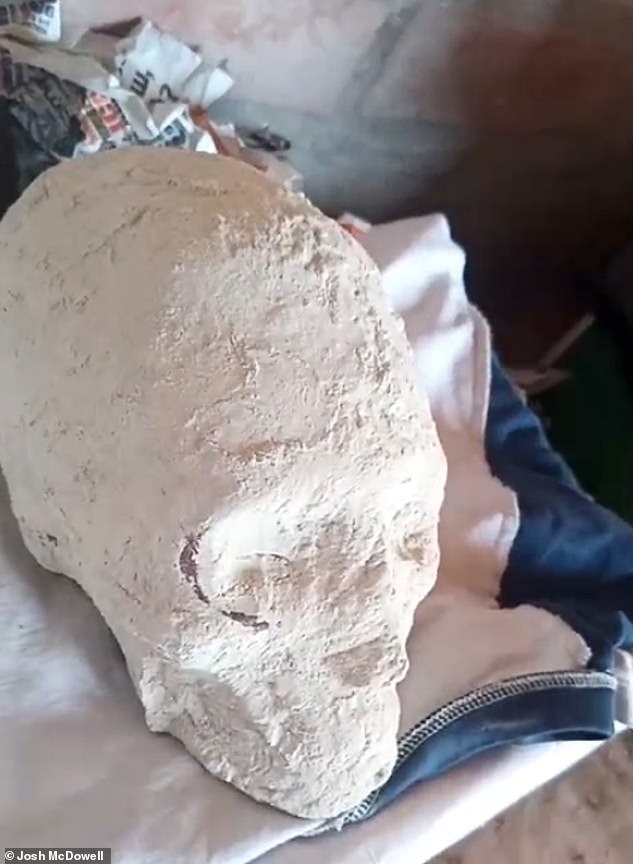
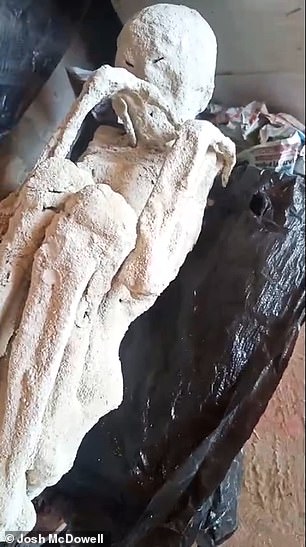
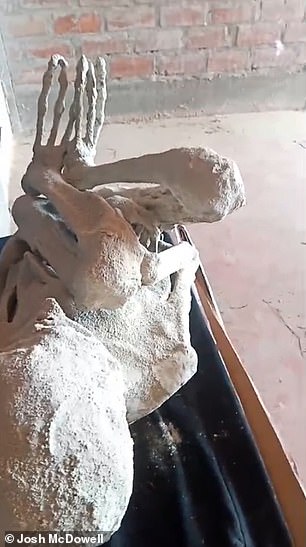
And forensic medical examiners from the United States — who inspected a trove of these ‘alien mummies’ this past April — are now also pleading with the government of Peru to authorize the bodies’ shipment to America for study in US labs.
Criminal defense lawyer Josh McDowell — the former prosecutor who obtained the new video — helped organize this team of senior forensic experts to get to the ground truth behind what have come to be known as the ‘Nazca mummies’ of Peru.
One member of that team, Josh’s father Dr John McDowell, described a gauntlet of diplomatic, legal and scientific hurdles to DailyMail.com, which must be cleared to analyze these mummified entities in the US ‘the right way from start to finish.’
In an exclusive interview, Dr McDowell also detailed exactly what key procedures would ultimately confirm or deny whether the bodies are ‘part of an elaborate hoax.’
But Dr McDowell also marveled at the sheer number of these Nazca ‘Tridactyls’ — so named for their three-toed feet and three-fingered hands, as seen in the new video.
‘I’ve seen bodies with extra fingers or toes, or a finger or toe, or a finger or toe that’s missing, genetically,’ he told DailyMail.com, ‘but never a big group like this.’
‘To see these tridactyl organisms,’ Dr McDowell continued, ‘all of them tridactyl, I have never seen that.’
The forensic odontologist has long consulted with law enforcement on dental record identifications, including the identification of victims after the 9/11 terrorist attacks on New York’s World Trade Center.
But the ‘dental detective‘ said he had never seen anything like the Nazca mummies, which numbered between six and 10 during his April trip to Peru, plus the new ‘beings’ documented in this recent video, two with claw-like, long and slender toes.
!['To see these tridactyl organisms,' forensic odontologist Dr John McDowell told DailyMail.com, 'all of them tridactyl, I have never seen that [...] never a big group like this.' Above, X-rays conducted on one of the apparent 'aliens' at the behest of Mexican journalist Jaime Maussan](https://conspiracyresource.com/wp-content/uploads/2024/08/new-video-reveals-two-more-alien-mummies-and-a-severed-alien-skull-3.jpg)
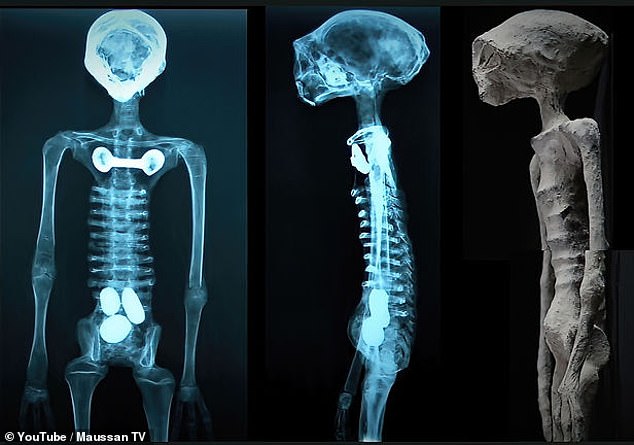
The videographer behind the new footage is unknown, in no small measure due to the thorny legal and ethical dimensions of handling these allegedly historical and culturally priceless ancient remains.
‘I don’t know who exactly shot the video, but there are context clues in the longer [version],’ one source, who had also been granted the tape, told DailyMail.com.
One of the ‘huaqueros’ who has long been involved in the promotion of these Nazca mummies was convicted of assault on public monuments for taking artifacts in 2022.
The man received a four-year suspended sentence and was fined about 20,000 Peruvian soles ($5,190 USD), according to Reuters: a clear example of the high-risk, extra-legal measures some have taken to seek either truth or profit from the ‘aliens.’
Nearly a year of international controversy has followed these peculiar specimens since September 2023, when veteran broadcast journalist and UFOlogist Jaime Maussan first presented two of the alleged ‘alien’ corpses to Mexico’s congress.
Maussan has now taken the Peruvian government to court hoping to ‘negotiate with Peru,’ as he put it, ‘to be allowed to export the samples to be done in America.’
‘The lawsuit is already in for $300 million,’ Maussan told DailyMail.com this June.
He explained that he is pursuing monetary damages to repair his enterprise’s damaged reputation, but intends to spend the cash on a museum for the mummies.
Dr McDowell himself has also recently pled with Peru’s government in an open letter published in one of the country’s top newspapers, La Noticia Perú, asking for official permission to study these specimens at top-flight scientific facilities in the US.

!['So far we have tomographies [CT scans] and fluoroscopy analysis,' Maussan told DailyMail.com describing the x-ray and ultrasound data on the mummies that he unveiled at West Hollywood's Mondrian Hotel at another press event (pictured above) on March 12, 2024](https://conspiracyresource.com/wp-content/uploads/2024/08/new-video-reveals-two-more-alien-mummies-and-a-severed-alien-skull-6.jpg)
Dr McDowell, who helped his son assemble the team of forensic experts who visited Peru last April, told DailyMail.com he was ‘eager to be associated with the trip.’
‘There are so many things that need to be analyzed to come up with definitive answers,’ he explained. ‘I think that’s very important.’
April’s trip brought Dr McDowell up close with at least half-a-dozen of the current Nazca mummies now held at Peru’s San Luis Gonzaga National University of Ica (UNICA).
The specimens have been given names like ‘María,’ who first debuted at a November 6, 2019 press event at UNICA, ‘Wawita,’ ‘Albert,’ ‘Victoria,’ and ‘Montserrat.’
‘It was interesting,’ Dr McDowell told DailyMail.com.
‘There are questions that need to be addressed, such as: Why have you got so many of them with this same external manifestation?’
If the Peruvian government and its Ministry of Culture were to give their approval, Dr McDowell said the next steps would be to carefully clean the diatomaceous earth, a powdery white dirt of fossilized algae, off the mummies and cut samples for testing.
‘We’ve talked about that a little bit,’ he said, ‘taking samples that could be used [for] DNA analysis on various sections of the body to be sure there isn’t co-mingling of different types of personages, humans or other animals that were mixed together.’
Proving that any individual mummy was not a fabricated hoax, he explained, ‘would involve taking multiple samples throughout the body.’
But, as a longtime consultant on criminal cases, Dr McDowell noted that maintaining ‘chain of custody’ throughout would be critical to reaching truly conclusive results.
‘If it were me, I’d want to accompany that specimen and make sure that, at every step, it was secure and under my direct supervision and control,’ he explained.
‘And I firmly believe that would be the position the Ministry of Culture in Peru would take as well,’ he opined.
Critics of Maussan’s long and winding public press tour with these ‘alien mummies’ have proposed two somewhat overlapping theories as to their origins.
Dr Flavio Estrada, a forensic archaeologist with the Peruvian government, concluded two of the smaller bodies seized by customs were nothing more than grisly dolls, ‘assembled with bones of animals from this planet, with modern synthetic glues.’
But as to the larger mummies, many skeptics, including Latin American historian Christopher Heaney at Penn State, suspect that the beings were once indigenous human practitioners of ancient ‘head-binding’ practices.
‘The Spanish, when they arrived in the 16th Century observed and commented on individuals walking around with very specifically shaped skulls,’ as Heaney told DailyMail.com, ‘and they recognized and saw them doing it using these bandages.’
Theories and accusations of fraud aside, Dr McDowell noted that more invasive and detailed examinations of the mummies would be necessary to identify their origins.
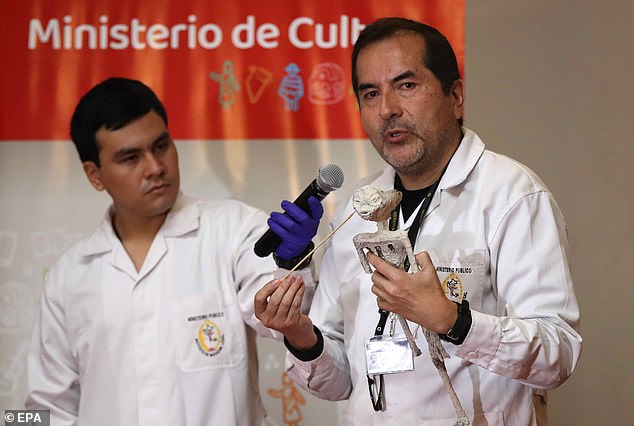
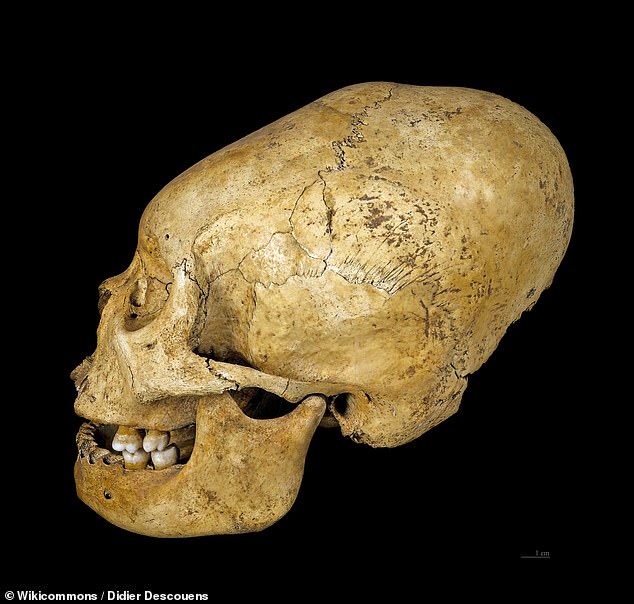
Toward that aim, the preliminary examinations he witnessed at UNICA in Peru this past April impressed him in terms of their transparency and professionalism.
‘We saw flat plane radiography, computer tomography [CT] and fluoroscopy that was done right in front of us,’ Dr McDowell told DailyMail.com.
‘And by “in front of us,” I mean, myself, Dr Caruso and also Dr Rodriguez.’
Dr McDowell was joined on this UNICA trip by Dr William Rodriguez, a forensic anthropologist with the Maryland State Medical Examiner; and Dr James Caruso, a US Navy veteran who is now the city of Denver’s Chief Medical Examiner.
‘Everything that we asked for,’ Dr McDowell added, ‘was allowed to be done.’
‘I never felt at any point that anything was withheld or obfuscated or kept occult from us,’ he said.
Those tests included the scan of the object’s chemical make-up via fluoroscopy, a method similar to hardware onboard NASA’s Mars Perseverance rover.
The noninvasive technique has gain prominence for examining the composition of a material without destroying or altering that material in the process, but researchers have also frequently reported on the technology’s limitations.
One group of environmental scientists in Arizona, for example, reported last year that their portable X-Ray fluorescence tests failed to accurately identify chromium metal content, due to high iron content drowning out the chromium’s signal.
Similarly noninvasive studies conducted on the bodies that Maussan brought before Mexico’s Congress led the head of the Mexican Navy’s Health Sciences Research Institute to declare them ‘a single skeleton that has not been joined to other pieces.’
But Dr McDowell noted that all of these kinds of non-surgical, scanning tests can only tell scientists so much about the true make-up of these unusual bodies.
‘We have done external evaluations as best we could,’ the forensic expert said.


Any deeper analysis of the mummies, Dr McDowell emphasized, would have to be conducted ‘in compliance with all international laws related to archeological finds.’
‘And even going further than that, we want to be sure that we’re culturally sensitive to these entities,’ he noted, ‘that we have respected the bodies.’
For a quarter century, the US and Peruvian governments have worked in concert to reduce the illicit trafficking of priceless Peruvian historical and cultural artifacts — rescuing over 2,000 ‘looted and stolen items now returned to Peru.
‘The reality is that there are federal laws and a Memorandum of Understanding between Peru and the US about the importation of archaeological artifacts that require State approval,’ Dr McDowell’s son, the defense attorney, told DailyMail.com
Their forensic team’s April trip to UNICA culminated in a chaotic press conference that was raided by police with Peru’s Ministry of Culture, who were intent on seizing one of the new mummified bodies on display, ‘Montserrat.’
The ordeal informed Dr McDowell’s decision to pen his open letter to Peruvian officials in La Noticia Perú, where he ‘respectfully requested that those in authority […] facilitate comprehensive evaluation of all of these recovered entities.’
‘Working together will certainly allow us to determine if any of these entities are unique and valuable archeological discoveries or are elaborate hoaxes (“engaños elaborados”),’ he wrote.
The key, he said, would be ‘direct examination of specimens free of contaminants.’
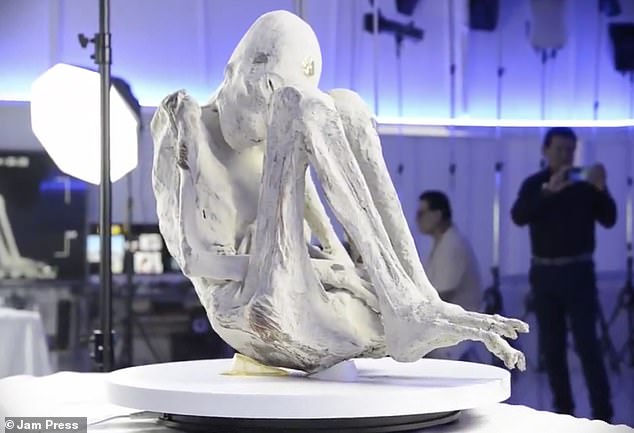
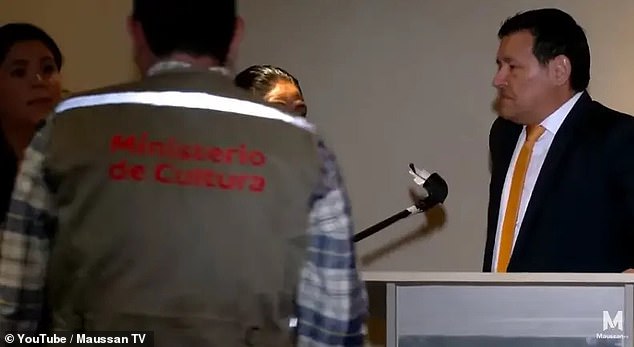
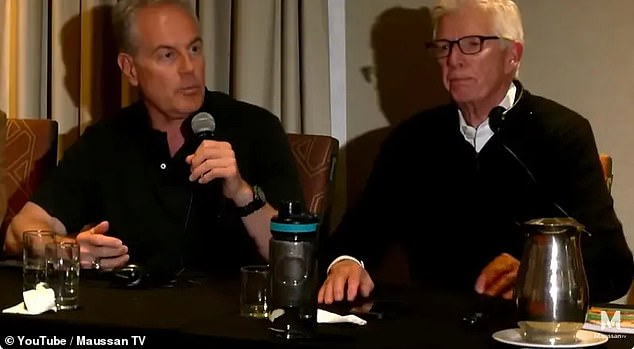
The issue of contamination, he noted, is a particularly high risk with respect to the carbon-dating of these mysterious mummies.
As an explainer published by the University of Chicago spells out, this process — which uses radioactive decay of an isotope of carbon, carbon-14, to estimate when a living thing has died — can be easily undermined by carbon from other sources.
‘Even a little extra carbon from contamination will throw off the results significantly,’ the school’s fact page noted.
‘A million-year-old sample contaminated by only a tiny amount of carbon could yield an invalid age of 40,000 years, for example.’
And these issues can become even more thorny in the case of a truly committed hoaxer, as physicist Dr Bente Philippsen explained it to DailyMail.com.
‘If, as an example, someone fabricated fake alien mummies from ancient animal bones,’ Dr Philippsen said, ‘the radiocarbon date would still say “ancient,” i.e., the time of death of the animal.’
Worse, Dr Philippsen noted that there are even more serious issues with using the technique on suspected extraterrestrial bodies.
‘Radiocarbon dating is, in fact, only applicable to samples that had lived on Earth, as other planets most probably have different production rates of 14C [the Carbon-14 isotope] in their atmosphere,’ said the physicist.
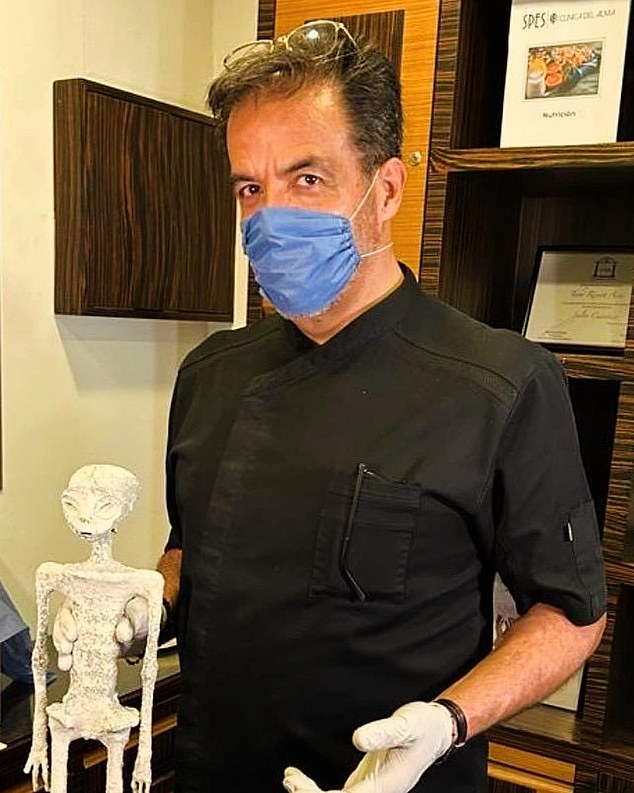
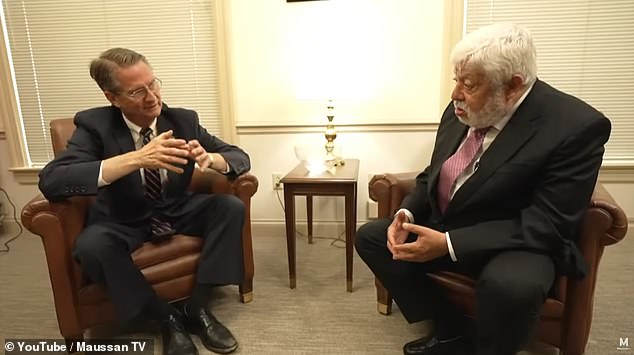
‘If we wanted to radiocarbon date the remains of alien visitors, we would need to have a calibration curve from their home planet,’ she added — while admitting this was simply a thought experiment.
Dr Philippsen, who leads the National Laboratory for Age Determination at the Norwegian University of Science and Technology, studied both physics and archeology, which together inform her work improving carbon-dating techniques.
In Dr McDowell’s view, exactly this kind of broad, cross-discipline work, done by a diverse array of scientists, will be needed to solve the Nazca mummies mystery.
‘As I said at the press conference, “None of us is as smart as all of us.”‘
‘We want to have anybody who’s taking a look at this, whether it’s an anthropologist or an archeologist, or any other expert in chemical analysis, DNA analysis, carbon dating, all of those working together,’ Dr McDowell told DailyMail.com.
‘If we work together,’ he said, ‘we’ll get it; we’ll get a good answer.’


